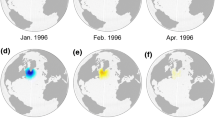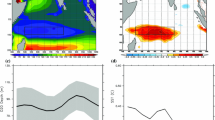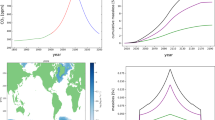Abstract
The bipolar ocean seesaw is a process that explains the competition between deep waters formed in the North Atlantic (NA) and in the Southern Ocean (SO). In this picture, an increase in the rate of formation of one of these water masses is made at the expense of the other. However, recent studies have questioned the effectiveness of this process. Namely, they show that adding freshwater in the SO can reduce deep water formation in the SO as well as in the NA. In this study, we explore the mechanisms and time scales excited by such a SO freshwater release by performing sensitivity experiments where a freshwater input is added abruptly in the ocean, south of 60°S, with different rates and durations. For this purpose, we evaluate the separate effects of wind, temperature and salinity changes, and we put the emphasis on the time evolution of the system. We find three main processes that respond to these freshwater inputs and affect the NA Deep Water (NADW) production: (i) the deep water adjustment, which enhances the NADW cell, (ii) the salinity anomaly spread from the SO, which weakens the NADW cell, and (iii) the increase in the Southern Hemisphere wind stress, which enhances the NADW cell. We show that process (i) affects the Atlantic in a few years, due to an adjustment of the pycnocline depth through oceanic waves in response to the buoyancy perturbation in the SO. The salinity anomalies responsible for the NADW production decrease [process (ii)] invades the NA in around 30 years, while the wind stress from process (iii) increases in around 20 years after the beginning of the freshwater perturbation. Finally, by testing the response of the ocean to a large range of freshwater release fluxes, we show that for fluxes larger than 0.2 Sv, process (ii) dominates over the others and limits NADW production after a few centuries, while for fluxes lower than 0.2 Sv, process (ii) hardly affects the NADW production. On the opposite, the NADW export is increased by processes (i) and (iii) even for fluxes smaller than 0.1 Sv. The climatic impact of the freshwater release in the SO is mainly a cooling of the Southern Hemisphere, of up to 10°C regionally, which increases with freshwater release fluxes for a large range of values.













Similar content being viewed by others
References
Alley RB, Clark PU, Huybrechts P, Joughin I (2005) Ice-sheet and sea-level changes. Science 310:456–460
Bard E, Hamelin B, Arnold M, Montaggioni L, Cabiochparallel G, Faure G, Rougerie F (1996) Deglacial sea-level record from Tahiti corals and the timing of global meltwater discharge. Nature 382:241–244
Blunier T, Brook EJ (2001) Timing of millennial-scale climate change in Antarctica and Greenland during the last glacial period. Science 291:109–112
Broecker WS (1998) Paleocean circulation during the last deglaciation: a bipolar seesaw? Paleoceanography 13:119–121
Brovkin V, Bendtsen J, Claussen M, Ganopolski A, Kubatzki C, Petoukhov V, Andreev A (2002) Carbon cycle, vegetation, and climate dynamics in the Holocene: experiments with the CLIMBER-2 model. Global Biogeochem Cycles 16:GB001662
Brix H, Gerdes R (2003) Influence of high-latitude surface forcing on the global thermohaline circulation. J Geophys Res 108:Art. no. 3022
Chen JH, Curran HA, White B, Wasserburg GJ (1991) Precise chronology of the Last Interglacial Period: U-234-Th-230 data from fossil coral reefs in the Bahamas. Geol Soc Am Bull 103:82–97
Crowley TJ (1992) North Atlantic deep waters cools the Southern Hemisphere. Paleoceanography 7:489–497
Driesschaert E, Fichefet T, Goosse H, Huybrechts P, Janssens I, Mouchet A, Munhoven G, Brovkin V, Weber SL (2007) Modelling the influence of Greenland ice sheet melting on the Atlantic meridional overturning circulation during the next millennia. Geophys Res Lett 34:L1070
Duplessy JC, Shackleton NJ, Fairbanks R, Labeyrie L, Oppo D, Kallel N (1988) Deep water source variation during the last climatic cycle and their impact on the global deep water circulation. Paleoceanography 3:343–360
EPICA Community Members (2006) One-to-one coupling of glacial climate variability in Greenland and Antarctica. Nature 444:195–198
Fichefet T, Hovine S, Duplessy J-C (1994) A model study of the Atlantic thermohaline circulation during the last glacial maximum. Nature 372:252–255
Ganachaud A, Wunsch C (2000) Improved estimates of global ocean circulation, heat transport and mixing from hydrographic data. Nature 408:453–457
Gnanadesikan A (1999) A simple predictive model for the structure of the oceanic pycnocline. Science 283:2077–2079
Gnanadesikan A, de Boer AM, Mignone BK (2007) A simple theory of the pycnocline and overturning revisited. In: Schmittner A, Chiang JCH, Hemming SR (eds) Ocean circulation: mechanisms and impacts, AGU monograph, Washington, pp 19–32
Goosse H, Fichefet T (1999) Importance of ice–ocean interactions for the global ocean circulation: a model study. J Geophys Res 104:337–355
Goosse H, Driesschaert E, Fichefet T, Loutre M-F (2007) Information on the early holocene climate constrains the summer sea ice projections for the 21st century. Clim Past 3:683–692
Hirschi J, Stocker TF (2002) Rapid changes of the oceanic circulation in a hierarchy of ocean models. Tellus A 54A:273–287
Johnson HL, Marshall DP (2002) A theory for the surface Atlantic response to thermohaline variability. J Phys Oceanogr 32:1121–1132
Kanfoush SL, Hodell DA, Charles CD, Guilderson TP, Mortyn PG, Ninnemann US (2000) Millennial-scale instability of the Antarctic ice sheet during the last glaciation. Science 288:1815–1818
Kawase M (1987) Establishment of deep ocean circulation driven by deep-water production. J Phys Oceanogr 17:2294–2317
Klinger BA Marotzke J (1999) Behavior of double-hemisphere thermohaline flows in a single basin. J Phys Oceanogr 29:382–399
Klinger BA, Drijfhout S, Marotzke J, Scott J (2003) Sensitivity of basin-wide meridional overturning to diapycnal diffusion and remote wind forcing in an idealized Atlantic–Southern Ocean geometry. J Phys Oceanogr 33:249–266
Knutti R, Fluckiger J, Stocker TF, Timmermann A (2004) Strong hemispheric coupling of glacial climate through freshwater discharge and ocean circulation. Nature 430:851–856
Liu Z, Alexander M (2007) Atmospheric bridge, oceanic tunnel, and global climatic teleconnections. Rev Geophys 45:RG000172
Marshall J, Jamous D, Nilsson J (1999) Reconciling thermodynamic and dynamic methods of computation of water-mass transformation rates. Deep Sea Res 46:545–572
McDermott DA (1996) The regulation of northern overturning by southern hemisphere winds. J Phys Oceanogr 26:1234–1255
Opsteegh JD, Haarsma RJ, Selten FM, Kattenberg A (1998) ECBILT: a dynamic alternative to mixed boundary conditions in ocean models. Tellus A 50:348–367
Philippon G, Ramstein G, Charbit S, Kageyama M, Ritz C, Dumas C (2006) Evolution of the Antarctic ice sheet throughout the last deglaciation: a study with a new coupled climate—north and south hemisphere ice sheet model. Earth Planet Sci Lett 248:750–758
Quadfasel D, Kase R (2007) Present-day manifestation of Nordic Seas outflows. In: Schmittner A, Chiang JCH, Hemming SR (eds) Ocean circulation: mechanisms and impacts, AGU monograph, Washington, pp 75–90
Rahmstorf S (1996) On the freshwater forcing and transport of the Atlantic thermohaline circulation. Clim Dyn 12:799–811
Rahmstorf S, England MH (1997) Influence of southern hemisphere winds on North Atlantic deep water flow. J Phys Oceanogr 27:2040–2054
Rohling EJ, Marsh R, Wells NC, Siddall M, Edwards NR (2004) Similar meltwater contributions to glacial sea level changes from Antarctic and northern ice sheets. Nature 430:1016–1021
Rooth C (1982) Hydrology and ocean circulation. Prog Oceanogr 11:131–149
Schmittner A, Saenko OA, Weaver AJ (2003) Coupling of the hemispheres in observations and simulations of glacial climate change. Quat Sci Rev 22:659–671
Schmitz WJ (1996) On the world ocean circulation, vol 1. Woods Hole Oceanographic Institute WHOI-96-03, p 141
Scott JR, Marotzke J, Stone PH (1999) Interhemispheric thermohaline circulation in a coupled box model. J Phys Oceanogr 29:351–365
Seidov D, Barron E, Haupt BJ (2001) Meltwater and the global ocean conveyor: northern versus southern connections. Glob Planet Change 30:257–270
Seidov D, Stouffer RJ, Haupt BJ (2005) Meltwater and the global ocean conveyor: northern versus southern connections. Glob Planet Change 49:19–27
Shin SI, Liu Z, Otto-Bliesner B, Brady EC, Kutzbach JE, Harrison SP (2003) A simulation of the last glacial maximum climate using the NCAR-CCSM. Clim Dyn 20:127–151
Speer K, Guilyardi E, Madec G (2000) Southern Ocean transformation in a coupled model with and without eddy mass fluxes. Tellus 52:554–565
Stocker TF, Wright DG, Broecker WS (1992) The influence of high-latitude surface forcing on the global thermohaline circulation. Paleoceanography 7:529–541
Stouffer RJ, Seidov D, Haupt BJ (2007) Climate response to external sources of freshwater: North Atlantic versus the Southern Ocean. J Clim 20:436–448
Stocker TF, Timmermann A, Renold M, Timm O (2007) Effects of salt compensation on the climate model response in simulations of large changes of the Atlantic meridional overturning circulation. J Clim 20:5912–5928
Stommel H (1961) Thermohaline convection with two stable regimes of flow. Tellus 13:224–230
Swingedouw D, Braconnot P, Delecluse P, Guilyardi E, Marti O (2007) Quantifying the AMOC feedbacks during a 2 × CO2 stabilization experiment with land-ice melting. Clim Dyn 29:521–534
Swingedouw D, Fichefet T, Huybrechts P, Goosse H, Loutre MF (2008) Antarctic ice-sheet melting provides negative feedbacks on future global warming. Geophys Res Lett 35:Art. no L17705
Talley LD (2003) Shallow, intermediate, and deep overturning components of the global heat budget. J Phys Oceanogr 33:530–560
Toggweiler JR, Samuels B (1995) Effects of the westerly wind stress over the Southern Ocean on the meridional overturning. Deep Sea Res 42:477–500
Trevena J, Sijp WP, England MH (2008) North Atlantic deep water collapse triggered by a Southern Ocean meltwater pulse in a glacial climate state. Geophys Res Lett 35:L09704
Tziperman E (1986) On the role of interior mixing and air–sea fluxes in determining the stratification and circulation of the ocean. J Phys Oceanogr 16:680–693
Vallis GK (2000) Large-scale circulation and production of stratification: effects of wind, geometry, and diffusion. J Phys Oceanogr 30:933–954
Walin G (1982) On the relation between sea-surface heat flow and thermal circulation in the ocean. Tellus 34:187–195
Weaver AJ, Saenko OA, Clark PU, Mitrovica JX (2003) Meltwater pulse 1A from Antarctica as a trigger of the Bolling-Allerod warm interval. Science 299:1709–1713
Weber SL, Drijfhout SS, Abe-Ouchi A, Crucifix M, Eby M, Ganopolski A, Murakami S, Otto-Bliesner B, Peltier WR (2007) The modern and glacial overturning circulation in the Atlantic Ocean in PMIP coupled model simulations. Clim Past 3:51–64
Acknowledgments
We are grateful to two anonymous reviewers for helpful advice and comments. We thank the European Marie Curie Research Training Network for Ice sheet and Climate Evolution (NICE) for its support. We also acknowledge the ASTER (Assessment of modelling uncertainties in long-term climate and sea level change projections) and BELCANTO (BELgian research on Carbon uptake in the ANTarctic Ocean) projects funded by the Belgian Science Policy for their support. The authors wish to acknowledge use of the Ferret program for analysis and graphics in this paper and the help of Patrick Brockmann for the use of this program.
Author information
Authors and Affiliations
Corresponding author
Appendix: Formation–diffusion equilibrium
Appendix: Formation–diffusion equilibrium
In this appendix, we explain how to obtain the Eq. 1 and how to calculate the terms of this equation in the model.
Following Speer et al. (2000), we firstly calculate a density flux defined as:
where S is the surface salinity, T is the surface temperature, C p is the specific heat of seawater, ρ is the density, E is the net freshwater fluxes, α is the thermal expansion coefficient and β the haline contraction coefficient.
From the buoyancy flux, we can define the transformation by air–sea fluxes from one density class to another:
Its derivative with respect to buoyancy (b = −gρ/ρ0) is called the formation (\({\mathcal{F}}\)) and represents the amount of new formation of a given water mass by air-sea buoyancy flux on a period T.
We define \({\fancyscript{A}}\) as the net advective flux across isopycnals:
where dΣ is the isopycnal surface area, \({\overrightarrow{V}}\) is the velocity and \({\overrightarrow{n}}\) is the unity normal vector to isopycnal.
We define \({\fancyscript{M}}\) as the mixing or diffusive flux across isopycnals:
where κ is the diapycnal diffusivity.
Ignoring volume fluxes across the sea floor and the sea surface, volume and mass conservation then write respectively:
where ψc is the streamfunction at the control surface. These equations give:
Lastly, we eliminate advection \({\fancyscript{A}}\) to obtain the volume balance of the isopycnal b (Speer et al. 2000) given by Eq. 11:
which allows to define the diapycnal mixing term as \({\mathcal{D}}=\partial_{{b}^2}{\fancyscript{M}}\) and the streamfunction export term as Ψ = ∂ b ψc. With this notation, we obtain the Eq. 1.
We calculate the different terms of Eq. 1 (Table 2) for different numerical experiments using δρ = 0.05 kg/m3 with monthly mean output for the different oceanic variables, which is precise enough according to the analysis from Speer et al. (2000).
Rights and permissions
About this article
Cite this article
Swingedouw, D., Fichefet, T., Goosse, H. et al. Impact of transient freshwater releases in the Southern Ocean on the AMOC and climate. Clim Dyn 33, 365–381 (2009). https://doi.org/10.1007/s00382-008-0496-1
Received:
Accepted:
Published:
Issue Date:
DOI: https://doi.org/10.1007/s00382-008-0496-1




